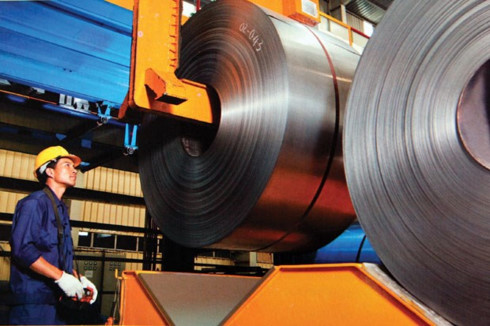Steel industry to face challenges in second half of 2019
Tue, 02 Jul 2019 15:10:00 | Print | Email Share:
In the second half of this year, increasing competition in product quality, prices and market share are predicted to force steel companies to work harder to maintain their foothold in the market.

Illustrative image (Photo: VNA)
Steel industry stocks have been fluctuating this year following the trend of the general market. From the first trading session of the year to mid-June, shares of giant steel maker Hoa Phat Group (HPG) fell by 0.069 percent and Nam Kim Steel Joint Stock Company (NKG) moved little, its shares inching down from 6,140 VND per share to 6,100 VND. Hoa Sen Group (HSG) and Vietnam Steel Corporation (TVN) went up and down during the period.
Le Duc Khanh, chief economist and chief strategy officer at PetroVietnam Securities JSC (PSI), said the US Federal Reserve was likely to reduce interest rates in July, but Vietnam was likely to suffer pressure over the rest of the year from inflation, exchange rates and rising interest rates, which would make it difficult for steel enterprises.
Other factors likely to have a big impact on the industry are geopolitical changes, the escalating US-China trade war, and the lack of steel supply caused by the damaged waste reservoir at the iron ore mine in Brumadinho, Minas Gerais State, Brazil, Khanh said.
He said the real estate market still had room for development in the remainder of 2019, so steel stocks were certain to find development opportunities. However, growth would depend much on the prestige of the business because customers only select high-quality products with competitive prices.
According Nguyen Duy Dinh, a stock analyst at MB Securities Co, the steel industry is facing difficulties related to high input costs such as electricity prices, oil prices and ore prices. However, steel enterprises with large-scale production can still earn contracts from major construction projects or find new export markets.
According to MB Securities Corp (MBS), demand in Vietnam is expected to increase by about 10 percent for long steel and flat steel products. Most of the industry's long steel output is consumed domestically, while about one third to one half of flat steel is exported.
For long steel, MBS forecasts consumption at approximately 12 million tonnes in 2019, accounting for 68 percent of total consumption. For galvanised steel products, consumption will be at 4.5-5 million tonnes.
Steel enterprises also face difficulties internally. Some businesses have a very high debt-to-equity ratio, which puts pressure on cash flow.
The analysis group from MBS said the number of industrial projects may rise thanks to the increase in foreign direct investment (FDI) and public spending on the infrastructure. Infrastructure spending in Vietnam has been growing at a double digit rate each year since 2012.
The defensive tax on imported steel is set to expire in 2021. However, with the increase of protectionism around the world and the importance of the steel industry for Vietnam, the tax is likely to be re-applied, which will put pressure on many exporters, MBS said.
The company predicted that Vietnam's steel industry will thrive in the long term due to the favourable macroeconomic environment and potential FDI flows.
According to the Vietnam Steel Association, in the first five months of 2019, steel production reached more than 10.5 million tonnes, up 9.2 percent over the same period in 2018. Sales of steel products reached more than 9.7 million tonnes, an increase of 11 percent, and steel exports hit 2 million tonnes, up 6 percent.
By: VNS/VNA/VOV
---------------------------------------------
Same category News :













